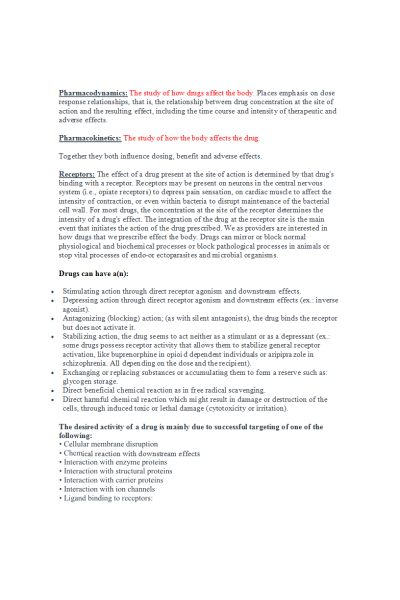NR 565 Week 1 Lesson Notes
-
$15.00
| Institution | NR 565 Advanced Pharmacology Fundamentals |
| Contributor | Nicole Albriton |
Pharmacodynamics: The study of how drugs affect the body. Places emphasis on dose response relationships, that is, the relationship between drug concentration at the site of action and the resulting effect, including the time course and intensity of therapeutic and adverse effects.
Pharmacokinetics: The study of how the body affects the drug.
Together they both influence dosing, benefit and adverse effects.
Receptors: The effect of a drug present at the site of action is determined by that drug's binding with a receptor. Receptors may be present on neurons in the central nervous system (i.e., opiate receptors) to depress pain sensation, on cardiac muscle to affect the intensity of contraction, or even within bacteria to disrupt maintenance of the bacterial cell wall. For most drugs, the concentration at the site of the receptor determines the intensity of a drug's effect. The integration of the drug at the receptor site is the main event that initiates the action of the drug prescribed. We as providers are interested in how drugs that we prescribe effect the body. Drugs can mirror or block normal physiological and biochemical processes or block pathological processes in animals or stop vital processes of endo-or ectoparasites and microbial organisms.
Drugs can have a(n):
Stimulating action through direct receptor agonism and downstream effects.
- Depressing action through direct receptor agonism and downstream effects (ex.: inverse agonist).
- Antagonizing (blocking) action; (as with silent antagonists), the drug binds the receptor but does not activate it.
- Stabilizing action, the drug seems to act neither as a stimulant or as a depressant (ex.: some drugs possess receptor activity that allows them to stabilize general receptor activation, like buprenorphine in opioid dependent individuals or aripiprazole in schizophrenia. All depending on the dose and the recipient).
- Exchanging or replacing substances or accumulating them to form a reserve such as: glycogen storage.
- Direct beneficial chemical reaction as in free radical scavenging.
- Direct harmful chemical reaction which might result in damage or destruction of the cells, through induced toxic or lethal damage (cytotoxicity or irritation)..................... continue
| Instituition / Term | |
| Term | 2021 |
| Institution | NR 565 Advanced Pharmacology Fundamentals |
| Contributor | Nicole Albriton |











































